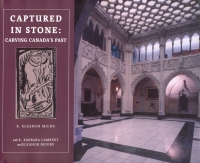| ________________
CM . . .
. Volume X Number 14 . . . . March 12, 2004
Recommended for students interested in art, architecture, and Canadian history, Captured in Stone is written in an accessible and descriptive style conveying Milne's love of her art and the warmth of her personality. Milne worked for over 30 years as the Dominion Sculptor creating, with her team whom she credits fully, the 40 by 1.5 metre frieze called the History of Canada Series. Her text describes the work of her team and some of the constraints that they worked under. She notes, briefly, her research that would be realized in symbolic and allegorical representations of the natural and human history of Canada. The purpose of the book is to convey the work of the team, the richness of Canada's history and the many people and events that shaped it, and Milne's love of sculpture. The majority of the book is illustrated with black and white photographs that serve an obvious purpose, but lack sharp resolution and thus do not show details of the stonework. There is also a diagram and excepts from poetry and songs. In these, and in Milne's words, the reader has a sense of the hard work that created both this country and the frieze.
The recommendation for the text is with reservations for several reasons. A strength of the book is that does discuss some of the unpleasant aspects of Canadian history that are depicted in the frieze. It also has a great deal of interesting information on sculpture, geology, and architecture. Its drawback is its organization which, even with a table of contents, is unclear. The text is divided up in much the same manner I suspect that the frieze in the Centre Block was: segments were created and brought together to form a whole through the work of a team. This may have worked well with the frieze but does not work well with this text. Milne writes well and with passion, but there is no flow to the narrative that jumps from topic to topic. Explanations of both a sculptor's tools and the architectural periods relevant to the Parliament building's architectural style are left to the end of the book where they might be missed by the reader. Key to appreciating the work created by Milne's team are the photographs. Unfortunately, the black and white photographs are of poor quality and convey no sense of the poetry created in stonework that is obviously vigorous and intricate. Sharp high resolution photographs would reveal the actual chisel marks of the sculptors or the grain of the limestone used which Milne describes as being integral to the success of the sculpture. At no point do the photographs convey Milne's description of the ambiance of the Foyer and its "immediate sense of invitation, of weightlessness and light." Many of the photographs are unnecessarily repeated. Milne also mentions that Pierre Trudeau joined the sculptors on their scaffolding while they worked late into the night. This incident would have been a fine opportunity to offer insight into Mr. Trudeau's personality. Nor is the reader told at what point in Trudeau's career this happened. A diagram with a time scale of Canadian history would have been helpful to convey what the frieze attempted to condense. The merit of Captured in Stone is in its sincerity. In a classroom situation, it would function best as an addition to a more detailed text. Recommended with Reservations. J. Lynn Fraser is the Communications Officer for The Centre for Research on Women's Health (Sunnybrook and Women's College Hospitals) and a freelance writer and editor in Toronto, ON.
To comment
on this title or this review, send mail to cm@umanitoba.ca.
Copyright © the Manitoba Library Association. Reproduction for personal
use is permitted only if this copyright notice is maintained. Any
other reproduction is prohibited without permission.
NEXT REVIEW |TABLE OF CONTENTS FOR THIS ISSUE - March 12, 2004. AUTHORS | TITLES | MEDIA REVIEWS | PROFILES | BACK ISSUES | SEARCH | CMARCHIVE | HOME |
